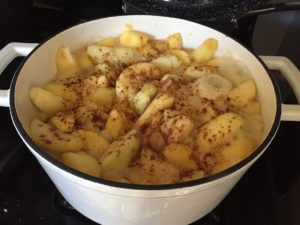
Applesauce in the making…slowly cooking and lightly dusted with pumpkin pie spice. Yum!
While this isn’t a tradition in my family, as I didn’t really have any, I wanted to start a new one with my own children. I didn’t have much of a role model for cooking when I was a child. My mom was adamant about her children not being in the kitchen when she was cooking – so learning how to cook wasn’t an option, unless you count Home Economics classes in middle school. Instead, I learned to cook much later in life and actually, from my ex-mother-in-law. She was exceptional at throwing food together without instruction and I inspired to be like her. Just as she had been kind to me in teaching me how to cook and sharing her recipes with me, I wanted to someday do that with my own children. When my daughter was old enough to safely help me in the kitchen, we cooked our first batch of apples from Oak Glen and canned them as well so we could have them for later. I felt good that my children would be eating something fresh, organic, and healthy and that I knew every ingredient that went into it. I loved that my daughter could help not only in making the applesauce, but has learned the lost art of canning. She is much older now and I’m glad she still has an interest in cooking with me. My son is still small, but he, too helps me in the kitchen and pretends to make me things to try. I’m glad that I chose to share my kitchen, this recipe, and other skills with my children. I hope they continue the tradition someday when they have children of their own.
Apples have been around for millions of years originating in the mountains of Kazakhstan. Archaeological finds have indicated that apples have been part of the human diet for over tens of thousands of years. Though North America had native apples called “crab apples”, in the U.S., apples began their profitable history arriving in Jamestown in the 1600’s, but they were not the sweet versions we have today. They were very tart and they were almost solely used to produce cider since it was a favorite and safer drink of the English colonists. Cider also became somewhat of a currency in the colonies, proving to be more profitable than tobacco. Over time, the French would introduce more edible varieties and over time, new breeds would be developed by the system of grafting and gene crossing.
Today, American’s eat about 19 pounds of apples each year, and they are grown in every state in the U.S. Over 7,500 types of apples exist today. There are about 7,500 apple orchards, producing about 48,000 tons each year to make $2.7 billion each year, making it the third most profitable crop behind oranges and grapes. One cup of chopped apple with skin is about 65 calories, and has low carbohydrates, good fiber, anti-oxidants, potassium, folate, niacin, and vitamins A, B, C, E and K. Apples are touted to lower the risk of stroke, cancer, diabetes, tooth decay, and developing Parkinson’s and Alzheimer’s disease.
